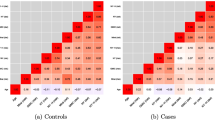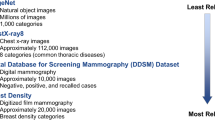Abstract
The ability to accurately estimate risk of developing breast cancer would be invaluable for clinical decision-making. One promising new approach is to integrate image-based risk models based on deep neural networks. However, one must take care when using such models, as selection of training data influences the patterns the network will learn to identify. With this in mind, we trained networks using three different criteria to select the positive training data (i.e. images from patients that will develop cancer): an inherent risk model trained on images with no visible signs of cancer, a cancer signs model trained on images containing cancer or early signs of cancer, and a conflated model trained on all images from patients with a cancer diagnosis. We find that these three models learn distinctive features that focus on different patterns, which translates to contrasts in performance. Short-term risk is best estimated by the cancer signs model, whilst long-term risk is best estimated by the inherent risk model. Carelessly training with all images conflates inherent risk with early cancer signs, and yields sub-optimal estimates in both regimes. As a consequence, conflated models may lead physicians to recommend preventative action when early cancer signs are already visible.
Access this chapter
Tax calculation will be finalised at checkout
Purchases are for personal use only
Similar content being viewed by others
Notes
- 1.
Cancer detection is the purview of established screening routines or CAD systems.
References
Bray, F., Ferlay, J., Soerjomataram, I., et al.: GLOBOCAN estimates of incidence and mortality worldwide for 36 cancers in 185 countries. CA Cancer J. Clin. 68(6), 394–424 (2018)
Duffy, S.W., Tabár, L., Chen, H.H., et al.: The impact of organized mammography service screening on breast carcinoma mortality in seven Swedish counties: a collaborative evaluation. Cancer Interdisc. Int. J. Am. Cancer Soc. 95(3), 458–469 (2002)
Kolb, T.M., Lichy, J., Newhouse, J.H.: Comparison of the performance of screening mammography, physical examination, and breast US and evaluation of factors that influence them: an analysis of 27,825 patient evaluations. Radiology 225(1), 165–175 (2002)
Gail, M.H.: Personalized estimates of breast cancer risk in clinical practice and public health. Stat. Med. 30(10), 1090–1104 (2011)
Tyrer, J., Duffy, S.W., Cuzick, J.: A breast cancer prediction model incorporating familial and personal risk factors. Stat. Med. 23(7), 1111–1130 (2004)
Yala, A., Lehman, C., Schuster, T., et al.: A deep learning mammography-based model for improved breast cancer risk prediction. Radiology 292(1), 60–66 (2019)
Dembrower, K., Liu, Y., Azizpour, H., et al.: Comparison of a deep learning risk score and standard mammographic density score for breast cancer risk prediction. Radiology 294(2), 265–272 (2019). https://doi.org/10.1148/radiol.2019190872
Glynn, R.J., Colditz, G.A., Tamimi, R.M., et al.: Comparison of questionnaire-based breast cancer prediction models in the nurses’ health study. Cancer Epidemiol. Prev. Biomark. 28(7), 1187–1194 (2019)
Boyd, N.F., Guo, H., Martin, L.J., et al.: Mammographic density and the risk and detection of breast cancer. New Engl. J. Med. 356(3), 227–236 (2007)
Brentnall, A.R., Harkness, E.F., Astley, S.M., et al.: Mammographic density adds accuracy to both the Tyrer-Cuzick and Gail breast cancer risk models in a prospective UK screening cohort. Breast Cancer Res. 17(1) (2015). Article number: 147. https://doi.org/10.1186/s13058-015-0653-5
Rauh, C., Hack, C., Häberle, L., et al.: Percent mammographic density and dense area as risk factors for breast cancer. Geburtshilfe Frauenheilkd. 72(08), 727–733 (2012)
Keller, B.M., Nathan, D.L., Wang, Y., et al.: Estimation of breast percent density in raw and processed full field digital mammography images via adaptive fuzzy c-means clustering and support vector machine segmentation. Med. Phys. 39(8), 4903–4917 (2012)
Amir, E., Freedman, O.C., Seruga, B., et al.: Assessing women at high risk of breast cancer: a review of risk assessment models. JNCI: J. Natl. Cancer Inst. 102(10), 680–691 (2010)
Geras, K.J., Wolfson, S., Shen, Y., et al.: High-resolution breast cancer screening with multi-view deep convolutional neural networks. arXiv preprint arXiv:1703.07047 (2017)
Shen, L., Margolies, L.R., Rothstein, J.H., et al.: Deep learning to improve breast cancer detection on screening mammography. Sci. Rep. 9(1), 1–12 (2019)
McKinney, S.M., Sieniek, M., Godbole, V., et al.: International evaluation of an AI system for breast cancer screening. Nature 577(7788), 89–94 (2020)
Sun, W., Tseng, T.-L.B., Zheng, B., Qian, W.: A preliminary study on breast cancer risk analysis using deep neural network. In: Tingberg, A., Lång, K., Timberg, P. (eds.) IWDM 2016. LNCS, vol. 9699, pp. 385–391. Springer, Cham (2016). https://doi.org/10.1007/978-3-319-41546-8_48
Qiu, Y., Wang, Y., Yan, S., et al.: An initial investigation on developing a new method to predict short-term breast cancer risk based on deep learning technology. In: Medical Imaging 2016: Computer-Aided Diagnosis, vol. 9785, p. 978521. International Society for Optics and Photonics (2016)
He, T., Puppala, M., Ezeana, C.F., et al.: A deep learning-based decision support tool for precision risk assessment of breast cancer. JCO Clin. Cancer Inform. 3, 1–12 (2019)
Bengio, Y., Louradour, J., Collobert, R., et al.: Curriculum learning. In: Proceedings of the 26th Annual International Conference on Machine Learning (2009)
Weinshall, D., Cohen, G., Amir, D.: Curriculum learning by transfer learning: theory and experiments with deep networks. In: International Conference on Machine Learning (2018)
Guo, C., Pleiss, G., Sun, Y., Weinberger, K.Q.: On calibration of modern neural networks. In: Proceedings of the 34th International Conference on Machine Learning, vol. 70, pp. 1321–1330. JMLR.org (2017)
Dembrower, K., Lindholm, P., Strand, F.: A multi-million mammography image dataset and population-based screening cohort for the training and evaluation of deep neural networks-the cohort of screen-aged women (CSAW). J. Digit. Imaging 33, 408–413 (2020). https://doi.org/10.1007/s10278-019-00278-0
Clunie, D.A.: DICOM implementations for digital radiography. RSNA 2003, 163–172 (2003)
He, K., Zhang, X., Ren, S., et al.: Deep residual learning for image recognition. In: Proceedings of the IEEE Conference on Computer Vision and Pattern Recognition (2016)
Wu, Y., He, K.: Group normalization. In: Proceedings of the European Conference on Computer Vision (ECCV), pp. 3–19 (2018)
Maas, A.L., Hannun, A.Y., Ng, A.Y.: Rectifier nonlinearities improve neural network acoustic models. In: Proceedings of ICML, vol. 30, p. 3 (2013)
Deng, J., Dong, W., Socher, R., et al.: ImageNet: a large-scale hierarchical image database. In: 2009 IEEE Conference on Computer Vision and Pattern Recognition. IEEE (2009)
Hinton, G.E., Srivastava, N., Krizhevsky, A., et al.: Improving neural networks by preventing co-adaptation of feature detectors. arXiv preprint arXiv:1207.0580 (2012)
Keller, B.M., Chen, J., Daye, D., et al.: Preliminary evaluation of the publicly available laboratory for breast radiodensity assessment (LIBRA) software tool: comparison of fully automated area and volumetric density measures in a case-control study with digital mammography. Breast Cancer Res. 17(1), 117 (2015)
Selvaraju, R.R., Cogswell, M., Das, A., et al.: Grad-CAM: visual explanations from deep networks via gradient-based localization. In: Proceedings of the IEEE International Conference on Computer Vision (2017)
Lindeberg, T.: Feature detection with automatic scale selection. Int. J. Comput. Vis. 30(2), 79–116 (1998). https://doi.org/10.1023/A:1008045108935
Acknowledgements
This work was partially supported by Region Stockholm HMT 20170802, the Swedish Innovation Agency (Vinnova) 2017-01382, the Wallenberg Autonomous Systems Program (WASP), and the Swedish Research Council (VR) 2017-04609.
Author information
Authors and Affiliations
Corresponding author
Editor information
Editors and Affiliations
1 Electronic supplementary material
Below is the link to the electronic supplementary material.
Rights and permissions
Copyright information
© 2020 Springer Nature Switzerland AG
About this paper
Cite this paper
Liu, Y., Azizpour, H., Strand, F., Smith, K. (2020). Decoupling Inherent Risk and Early Cancer Signs in Image-Based Breast Cancer Risk Models. In: Martel, A.L., et al. Medical Image Computing and Computer Assisted Intervention – MICCAI 2020. MICCAI 2020. Lecture Notes in Computer Science(), vol 12266. Springer, Cham. https://doi.org/10.1007/978-3-030-59725-2_23
Download citation
DOI: https://doi.org/10.1007/978-3-030-59725-2_23
Published:
Publisher Name: Springer, Cham
Print ISBN: 978-3-030-59724-5
Online ISBN: 978-3-030-59725-2
eBook Packages: Computer ScienceComputer Science (R0)





